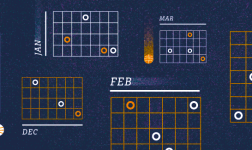How does the NCAA Division I Men’s Basketball Tournament Selection Committee pick the teams that get to participate in the tournament each year? And more importantly, is there a mathematical formula out there that we can discover that approximates its choices?
“Bracketology,” as it is called in some circles, is more of an art than a science, but as we narrow down the field it becomes increasingly more difficult to do, not only justifying one team over another but figuring out just what the committee is looking at when it makes its decisions. What can an athletic director (AD) do to have the best chances for the men’s basketball team to be NCAA tournament eligible? On this question, our review of the research and literature did not uncover actionable findings on point for athletic directors 1 so we decided to conduct this empirical study to provide answers.
Our first goal with this research is to present a multitude of minimums, specific statistics, and six performance thresholds, which must be reached in order for your school’s team to have any shot at making it off the bubble and into the tournament (without winning your conference tournament, of course). Our second goal is to examine a seventh performance metric more in-depth in order to provide athletic directors with actionable data that will allow them to place their men’s basketball team in the best position possible for making it into the NCAA tournament in upcoming seasons.
For background purposes, the first 33 spots in the NCAA tournament always go to the champions of the respective conference tournaments that take place the week before the first week of the NCAA tournament (except in the Ivy League, which sends its regular-season champion to the tournament.) That part is simple, easy, and fair. So that currently leaves 35 spots for at-large teams, those teams that the committee deems most worthy. To do this the tournament selection committee looks at things like win-loss record, ratings percentage index (RPI) ranking, strength of schedule (SoS), teams’ record over their last 10 games, and other statistics to figure out who deserves to be in.
The first 25 or so of those at-large spots are pretty easy to fill—there can only be one conference champion from the Big East or Atlantic Coast Conference, for instance, but those power conferences usually have a dozen teams between them who most consider worthy of being included in the tournament. Other bigger conferences also usually have two to four other teams besides their champion that are easy picks for the committee. Teams at the top of the polls and in the RPI rankings are near locks to be at-large picks: since 2001, all of the teams with an RPI ranking of 18 or better have been invited to the tournament. In fact, teams with an RPI ranking of 35 or better have been invited to the tournament 97% of the time. So it is the last 10 picks or so that are the toughest, and those are the ones that we’re focused on here.
We gathered a list of all the bubble teams over the last 11 seasons (553 total teams who played 17,023 total regular-season games), which consisted of the last teams into the tournament and the first teams left out of the tournament. We define a last team in as one that was an at-large team that received a double-digit seed (10 or higher). (This is because even though a tournament champion might receive an automatic bid, that doesn’t mean it’s entitled to a high seed—all seeding is done after the field has been established and is done on the basis of how strong or deserving the committee deems the teams to be, regardless of how they got into the tournament.) Though, before we could start, we had to discard six teams that were on NCAA or self-imposed post-season probation and were therefore ineligible for the tournament.
We define first team out as one that reached at least one of the following benchmarks:
- 20 wins
- RPI rank of under 86
- .500 or better conference record in a Big-6 conference, .700 or better in a non–Big-6 conference
Those three benchmarks gave us a list of 469 more schools—not including the 78 who made it off the bubble and into the tournament—that could be considered for the 2001-2011 tournaments, or approximately 50 teams per season.
That’s a lot of bubble teams (547 total), so in order to start paring the list down we had to start setting the minimums. We began by looking at the teams who might have made the cut in one of those above categories but definitely did not stack up in the others. We discarded all of the teams that had overall winning percentages under .500 or fewer than 16 wins, since no team with less than a .576 winning percentage or 17 wins has made the tournament. (Note: all of the statistics are valid only since the 2001 season, so the qualifier “in the last 11 seasons” can be added to all such statements.) These minimums have stayed relatively stable for the last six seasons.
Next we eliminated teams that did not have an RPI ranking under 76, since no team ranked over 66 has made the tournament [fig. 1]. We gave teams more of a buffer here because that cutoff is rising—it’s only been in the last two seasons that teams with RPIs in the 60s have made it into the tournament.
Fig. 1 — RPI of Last Teams In (Blue) and First Teams Out (Red)
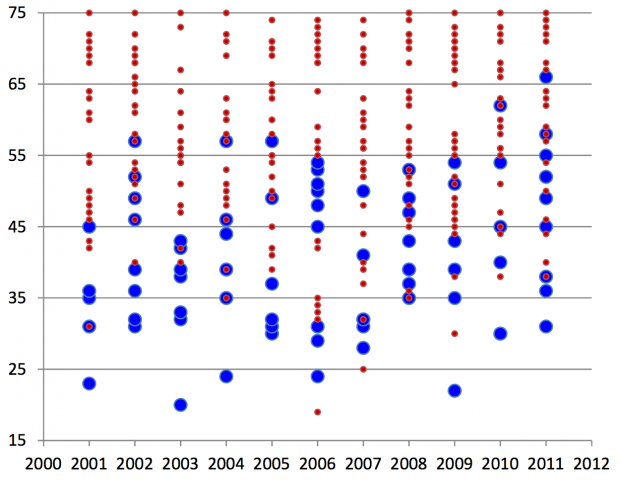
Over the last decade or so, the committee’s focus on RPI rank has started to slip a bit [fig. 2]. Of course, some of this is due to teams winning their conference tournament that would not be considered for an at-large bid, therefore taking a spot away from a more-deserving bubble team, but that doesn’t account for the trend entirely.
We know the tournament selection committee looks at conference standing, so conference winning percentage becomes extremely important as well. We didn’t want to automatically discard teams that were under .500 in conference play because of the 78 double-digit seeds we studied that made it into the tournament, seven of them had losing records in their conference. But we did find a very strong correlation between conference winning percentage and conference RPI rank among our last teams in [fig. 3].
Fig. 2 — Average RPI Rank of Last Teams In
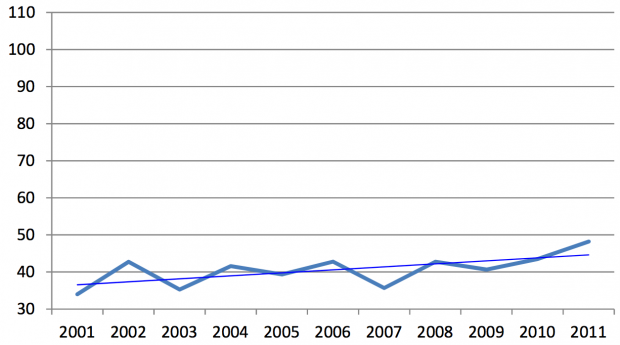
Fig. 3 — Conference Winning Percentage × Conference RPI Rank
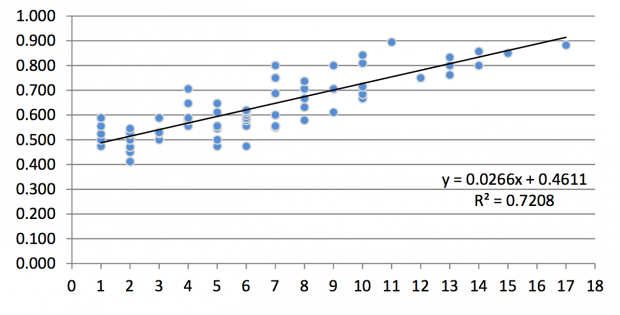
This basically shows that the higher a team’s conference is ranked, the lower the acceptable winning percentage in that conference is for a team. No team with fewer than seven conference wins has ever made the tournament, and teams with fewer than 10 have made it only 12 times—and the average conference rank for those teams was 2.83, with the worst being No. 6. So a general rule of thumb is that your number of conference wins needs to be higher than your conference’s RPI rank.
The next one is a pretty easy one: you need to have a .500 record or better in non-conference games. Only one team has managed to get into the tournament being under .500 in non-conference games (Kentucky was 6-7 in 2008), and it went 12-5 in a Southeastern Conference that was No. 4 in conference RPI ranking.
Something else the NCAA selection committee looks at is a team’s record over its last 10 games. There are 11 teams that have made it into the tournament even after going 4-6 in their last 10 games, but no team has ever made it in going 3-7 in the last 10 games. So it’s a worthy minimum to add: you must win more than three of your last 10 games.
So those are the six minimums we’ve established:
- A .575 or better overall winning percentage
- 17 wins
- An RPI ranking under 76
- More conference wins than your conference RPI rank
- A .500 or better winning percentage in non-conference play
- A .400 or better winning percentage in your last 10 games
If you fail to reach ANY of these minimums, your tournament bubble is almost guaranteed to pop.
There’s one more major metric that comes into play in March: SoS. However, we didn’t create a minimum for SoS because the floor is so low: more than a quarter of the 78 last teams in we studied had SoS ranks over 100, and eight of them made it into the tournament with SoS ranks over 150. But it is worth noting that the committee is focusing much more on SoS now than it was even 10 years ago. Fig. 4 shows the previous RPI ranking chart [fig. 2] with SoS ranking added in:
Additionally, while the other minimums are mostly based on wins, SoS is something that athletic directors can influence directly. But SoS is a tricky nut to crack. On one hand, you want to play an easy enough schedule that will allow your team to get as many wins as possible, but at the same time you must play a tough enough schedule that those wins matter and hold value in the eyes of the tournament selection committee. The best you can hope for are worthy, though beatable, non-conference opponents and conference opponents that do well enough in their own non-conference games to raise the conference’s standing.
The first thing to realize about SoS is that it’s a double-edged sword: while a bad ranking might not hurt your tournament chances too much, a good ranking might not help them too much, either [table 1].
Fig. 4 —Average RPI Rank of Last Teams In Considering SoS
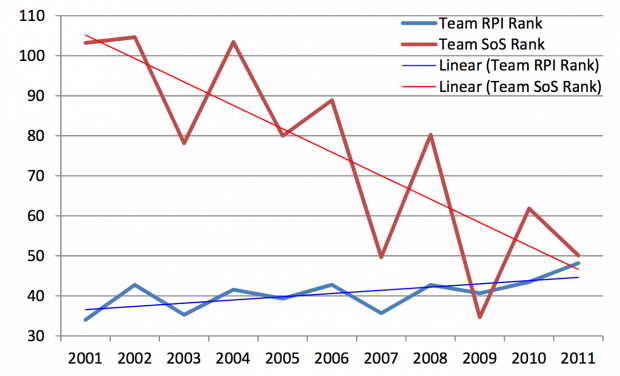
Table 1 -SoS Impact on Deciding Last Team In
| Season | No. of Last Teams In (At-Large, Seeded No. 10-12) | Worst Last Team In SoS | Teams Left Out with Better SoS Ranking than Worst Last Team In |
|---|---|---|---|
| 2001 | 5 | 125 | 29 |
| 2002 | 8 | 205 | 41 |
| 2003 | 7 | 184 | 35 |
| 2004 | 7 | 208 | 39 |
| 2005 | 6 | 128 | 16 |
| 2006 | 9 | 180 | 40 |
| 2007 | 6 | 114 | 29 |
| 2008 | 8 | 192 | 35 |
| 2009 | 6 | 94 | 23 |
| 2010 | 6 | 122 | 29 |
| 2011 | 10 | 92 | 20 |
That’s an average of 30 teams per season that had better SoS than the last team into the tournament. Of course, just because teams that were left out had a better SoS ranking doesn’t mean they were more qualified. In fact, many of those teams simply had unacceptable win-loss records (a strong SoS doesn’t mean anything unless you win most of your games.) When we look at the intersection of SoS and W-L, we find a pretty solid guide to where your SoS needs to be based on your record [fig. 5].
In general, looking at just wins, we can see that the more wins you have, the lower your SoS rank can be. Table 2 gives a pretty good guide to where a team should be.
In fact, winning percentage actually correlates better with SoS rank than straight wins [fig. 6] but doesn’t produce as easy of a comparison table.
Fig. 5 —Wins and SoS Rank
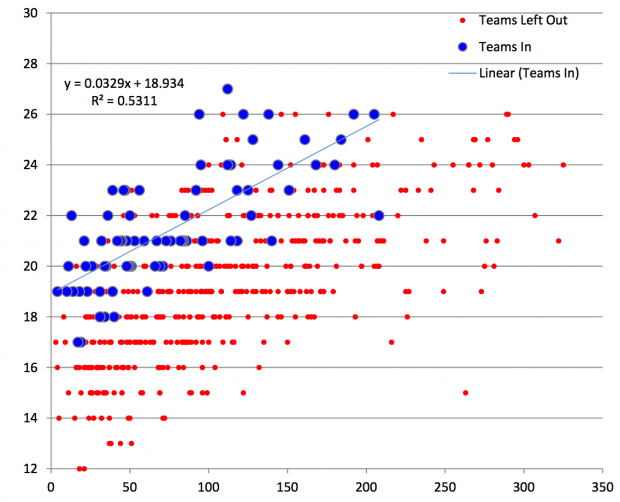
Fig. 6 —Overall Winning Percentage and SoS Rank
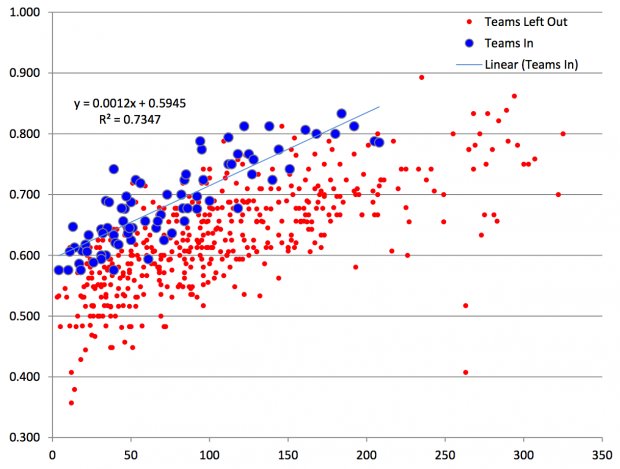
Table 2 – Relationship between Wins and SoS Target Rank
| Wins | SoS Target Rank |
|---|---|
| 18 | 32 or better |
| 19 | 63 or better |
| 20 | 93 or better |
| 21 | 124 or better |
| 22 | 154 or better |
| 23 | 184 or better |
| 24-27 | 215 or better |
So depending on how good you think your team is going to be in the upcoming years, you can attempt to tailor your SoS. If you have a lot of returning starters, think you’re going to finish high in the conference, or will win 20 or more games, you can opt for an easier non-conference schedule. On the other hand, if you’re going to be breaking in a new class, have strong conference competition, or project winning fewer than 20 games, you might have to roll the dice and attempt to arrange a tough non-conference schedule.
But another tricky part of the SoS problem is that even if you’re explicitly trying to arrange an easy or tough schedule, you can’t definitively know if the teams you’re scheduling are going to be good and help your SoS or bad and hurt your SoS. But in looking at all these teams, we’ve been able to find some solid statistics that should help you project how good your possible opponents are going to be in the upcoming season.
First we looked at all of our bubble teams to see how much their RPI fluctuated from year to year. We ended up with 184 teams that were on the bubble in two consecutive years. The average change in their RPI rankings was 23 spots, either up or down, which is quite helpful to know. We also decided to examine every other Division I-A team (3,314 of them) between 2002 and 2011, to see how much their RPI rankings fluctuated. The average change for that group was a bit higher at just over 51 spots per year, either up or down. Table 3 breaks those statistics down even more, looking at the number and percentages of teams that were within 10, 20, and 30 spots of their previous year’s final RPI ranking.
The reason for the differences between the bubble teams and all Division I-A teams can be attributed to the fact that the RPIs of highly ranked teams will change less the following season than the RPIs of lower-ranked teams [fig. 7]. Specifically, teams ranked in the top 50 will have less fluctuation than teams ranked higher than 50.
It seems logical and intuitive—if you want a harder schedule, schedule better non-conference teams. But the data here are proving it and giving the parameters for maximizing your chances at having the SoS you want. So basically you can now create your non-conference schedules for the following year with a higher degree of certainty as to what your SoS might be and how that in turn will affect your NCAA tournament chances.
Table 3 —RPI Fluctuation of Bubble Teams from Year to Year
| 183 Bubble Teams | Percent of Teams% | 3,314 Division I-A Teams | Percent of Teams% | |
|---|---|---|---|---|
| Within 10 Spots of Previous Season’s Rank |
52 | 28.4% | 548 | 16.5% |
| Within 20 Spots of Previous Season’s Rank |
96 | 52.5% | 989 | 29.8% |
| Within 30 Spots of Previous Season’s Rank |
128 | 69.9% | 1380 | 41.6% |
Fig. 7 —Spots Change in RPI from Previous Year
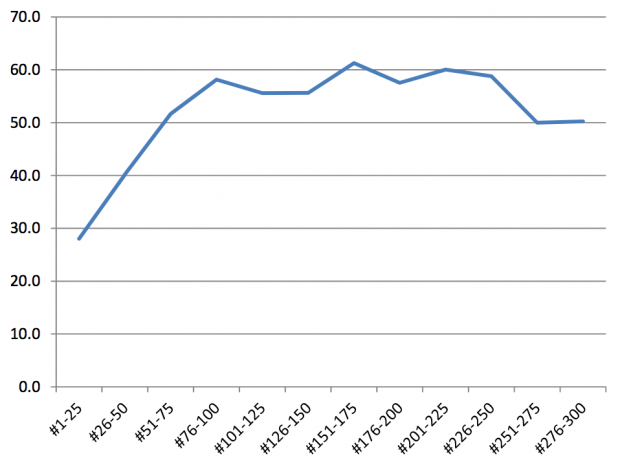
Key Insights
Strength of schedule is one of the few parameters the athletic director can influence directly, but it requires the ability to forecast his/her team’s strength in future seasons. If a talented, veteran team will be returning, an easier non-conference schedule might put it into optimal position for the NCAA tournament. However, if the team will be young and might struggle, the best chance to make the tourney might be to boost strength of schedule with a difficult non-conference slate.



